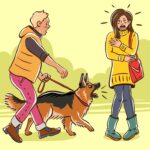Can My Dog Get Lice From My Kid
Can My Dog Get Lice from My Kid? The Surprising Answer
As a pet owner and parent, you may have wondered if your furry friend could catch lice from your child. After all, both lice and dogs are common sources of itching and scratching. However, the answer is not as simple as yes or no. In this article, we will explore the facts and myths about lice infestations in dogs and humans, and give you practical tips on how to prevent and treat them.
What Are Lice?
Lice are tiny parasites that feed on blood and live on the skin or hair of their hosts. There are three main types of lice that affect humans: head lice, body lice, and pubic lice (also called crabs). Head lice are the most common type and usually spread through direct contact with infected hair or objects such as combs, hats, or pillows. Body lice can also transmit diseases such as typhus and trench fever, but they are more common in crowded or unsanitary conditions. Pubic lice primarily affect the genital area but can also infest other hairy parts of the body.
Dogs can also get lice, but their species-specific louse is different from human louse. Canine lice (Trichodectes canis) only infest dogs and other canids such as wolves or foxes. They do not affect humans directly but may cause temporary itching or irritation if they come into contact with human skin. Canine lice are less common than fleas or ticks in dogs but can still be a nuisance for some pets.
Can Dogs Get Human Lice?
The short answer is no. Dogs cannot get human head lice, body lice, or pubic lice because these parasites are adapted to different host species. Even if your dog snuggles with your child or shares a bed with them, the risk of lice transmission is very low. However, if your dog has his own lice problem, he can pass it to other dogs or puppies in the same household or kennel. Therefore, it’s important to detect and treat lice infestations in dogs as soon as possible.
How Do Dogs Get Lice?
Dogs usually get lice from direct contact with another infested dog or from sharing contaminated bedding, toys, or grooming tools. Lice cannot jump or fly like fleas but can crawl quickly on hair or skin. Younger dogs or those with weaker immune systems may be more susceptible to lice infestations than healthy adult dogs. Symptoms of canine lice may include:
– Intense itching and scratching
– Hair loss or thinning
– Redness or inflammation of the skin
– Dry or flaky skin
– Scabs or crusts
If you suspect that your dog has lice, you should take him to the vet for a physical exam and diagnosis. The vet may use a magnifying glass or a microscope to identify the lice and recommend a suitable treatment.
How Do You Treat Canine Lice?
The treatment for canine lice depends on the severity of the infestation and the age and health of your dog. Some common methods used by vets include:
– Topical insecticides: These are applied directly to the skin and fur of your dog and kill the adult lice and their eggs. They may need to be repeated after a few weeks to ensure complete elimination.
– Oral medications: These are pills or liquids that your dog can swallow to kill the lice from inside out. They may have side effects such as vomiting or diarrhea and should not be given to pregnant or nursing dogs.
– Shampoos and dips: These are medicated baths that can kill the lice on contact but may require multiple treatments. They are not recommended for dogs with sensitive skin or allergies.
In addition to these treatments, you should also clean and disinfect your dog’s bedding, toys, and grooming tools to prevent reinfestation. You may also need to isolate your dog from other dogs until he is lice-free.
How Do You Prevent Lice in Dogs?
The best way to prevent lice in dogs is to maintain good hygiene and health practices. Some tips you can follow include:
– Regular grooming: Brushing your dog’s hair and coat can help remove any loose hair or debris that may harbor lice or their eggs. Use a flea comb or a fine-toothed comb to check for lice or nits (lice eggs) near the base of the hair shafts.
– Bathing your dog: Use a mild shampoo that is designed for dogs and rinse thoroughly. Avoid using human shampoos or harsh chemicals that may irritate your dog’s skin or eyes.
– Keeping your dog away from known sources of lice: If you know that a dog in your neighborhood or park has lice, avoid letting your dog interact with them or their belongings.
– Boosting your dog’s immunity: Provide your dog with a balanced diet, plenty of fresh water, exercise, and regular veterinary check-ups to ensure that he stays healthy and strong.
Conclusion
While it’s unlikely that your dog will catch head lice from your kid, he can still get canine lice from other dogs or objects. Therefore, it’s important to be aware of the signs and symptoms of lice infestations in dogs and take prompt action if necessary. By following the tips we’ve outlined in this article, you can keep your furry friend happy and healthy, while also protecting your family from parasitic pests. Remember, prevention is always better than treatment!



